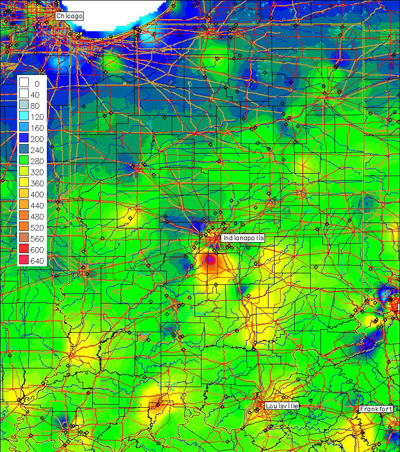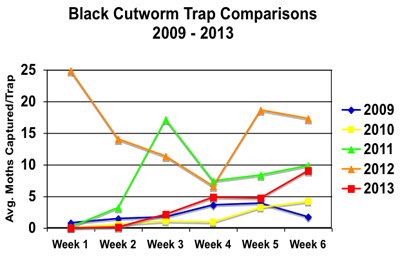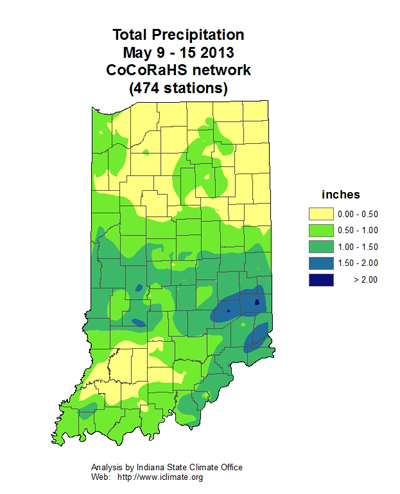USDA-NIFA Extension IPM Grant
Pest & Crop Newsletter, Entomology Extension, Purdue University
Black Cutworm Development May Coincide With Emerging Corn - (Christian Krupke and John Obermeyer)
• Black cutworm moths continue to arrive.
• Larval development will surge with recent high temperatures, scouting of high-risk, emerged fields in southern and central counties is highly recommended.
• Seed insecticides and Bt-corn will provide suppression of this pest, NOT control heavy populations.
• Insecticides tank-mixed with burn-down herbicides have their limitations.
Delayed planting, coupled with significant egg laying in weedy fields combine to have potential for significant cutworm damage within the week. We track the development of the black cutworm from the time of an intensive capture (mid-April) to predict first cutting/damage (refer to accompanying map). Based on the growth development model, it takes approximately 300 heat units (above the 50?F base) from egg hatch to the stage when black cutworm larvae begin to cut plants. Leaf injury, though less noticeable, will likely be present before cutting, as this is done by smaller larvae. Using pheromone trapping of moths and tracking of heat unit accumulations for first cutting is not an exact science, but they do give us a good indication of what to expect and when to start looking. However, it is not possible to predict if individual fields will be infested.
Accumulated Heat Units (Base 50) for Black Cutworm Development Since April 18
With many areas of Indiana just planted, or being planted now, moths may have found these weedy fields as an ideal egg-laying site. Tillage at, or just before, planting will provide little control of the eggs or newly hatched larvae – it will mostly serve to move them around a bit. Since black cutworm has been a minor pest the past several years, producers may have a false sense of security with the seed-applied insecticides and/or Bt-corn.
Many fields, especially those with significant weed/cover crops, are being treated with a foliar insecticide at the time of herbicide burn-down. We can understand the proactive approach, especially with the delayed planting. Understand that these insecticides have their limitations, specifically when subjected to sunlight, rainfall, heat, and dust. Claims of multiple weeks of control with foliar insecticides in spring conditions are simply unfounded; 7-10 days of control is the most optimistic measure. Remember that these are contact insecticides, and as soon as they hit the soil, breakdown begins. Some good news: as soil temperatures rise with the sudden surge in temperatures, corn should emerge and grow quickly. We can manage this pest effectively and have done so in the past: Timely scouting and rescue foliar insecticides when necessary are the tried and true approach with black cutworm. Happy scouting!
![]()
Click here to see the Black Cutworm Adult Pheromone Trap Report
![]()
Click here to see the Black Light Trap Catch Report
![]()
Control of Dandelion in No-till Corn and Soybean – (Travis Legleiter and Bill Johnson)
The warmer, drier conditions of the last couple of weeks have allowed producers to start spring planting operations in a majority of the state. Among those operations have been spring burndowns in no-till fields and from what we have observed so far many of those fields have high populations of dandelion. We have noticed that many fields that have already received a spring burndown often failed to control the dandelions. The increased amounts of dandelion and failed control are a combination of many factors.
The sudden increase in dandelion populations is due to weather conditions from last summer through this spring. Last years summer drought lead to the destruction or early harvest of many corn fields followed by a fall that provided some rainfall relief. Dandelion plants emerge in the fall and spring and in such case as last year the early opening of cornfield canopies and a moist fall were perfect conditions for the fall emerging dandelion. The dandelion plants that emerged were likely allowed to persist through the winter and have now taken advantage of the delayed spring and have produced large rosettes that are no doubt hard to control.
Dandelion is a hard to control weed anyway, but when allowed to establish as it has in many fields this spring it is especially hard to control. The most effective time to control dandelion is in the fall with a 2,4-D plus chlorimuron (Canopy/Cloak DF/EX) herbicide application. Spring burndowns should contain more than just glyphosate and 2,4-D to achieve effective control of dandelion. In no-till corn the best burndown option is Lumax/Lexar plus 2,4-D ester. The addition of chlorimuron or cloransulam to a glyphosate plus 2,4-D tank mix will achieve the best dandelion efficacy in no-till soybean, with chlorimuron having the superior control.
Producers who have already applied a spring burndown and failed to control dandelion still have a few options for control of those dandelion plants that were not controlled. In corn a post emerge application of dicamba or dicamba plus steadfast ATZ will provide additional control. Combinations of HPPD inhibitors Callisto or Laudis/Corvus plus atrazine will also control previously injured dandelion plants in corn. As similar to the burndowns an addition of Classic or Firstrate to the glyphosate tank will help suppress previously injured dandelion in soybean.
Producers who have experienced increased dandelion pressure this spring should consider scouting their fields this fall for dandelion seedlings and consider a fall burndown to decrease populaitons that will occur next spring.
For further information on dandelion control refer to the Ohio and Indiana Weed Control Guide. Specific dandelion recommendations can be found on page 158.
![]()
Update on Fusarium Head Blight and Stripe Rust of Wheat - (Kiersten Wise)
Wheat growth stages vary across the state, but many fields are flowering or beginning to flower in areas of southern/central Indiana. These regions are at low to moderate risk for Fusarium head blight (FHB) development, however the intermittent rains and warmer temperatures will likely increase risk of disease development.
Stripe rust of wheat has now been reported in several counties in southern IN. The disease is at low incidence and severity in fields. The fungus that causes stripe rust (Puccinia striformis) produces a yellowish or orange spore, and pustules appear in a row on infected leaves, giving it a “striped” appearance (Figure 1). Purdue Extension Bulletin BP-79-W, “Identifying Rust Diseases of Wheat and Barley” is available to aid in diagnosis of stripe rust, and can be found at the following link: <https://mdc.itap.purdue.edu/item.asp?itemID=19349>. Fungicide applications for FHB management in these areas will also limit development of stripe rust.
Fields should be scouted for stripe rust prior to the decision to make a fungicide application. Stripe rust has not been confirmed in central or northern IN yet, but may develop and coincide with the timing of a fungicide application for FHB suppression in these areas. Fungicide applications to manage FHB need to be made at Feekes 10.5.1, or early flowering. The fungicides available for Fusarium head blight control are also effective at managing stripe rust, should the need arise. Foliar fungicides available for control are listed in the foliar fungicide efficacy table developed by the North Central Regional Committee on Management of Small Grain Diseases or NCERA-184 committee, and through the Purdue Extension bulletin BP-162-W: <https://ag.purdue.edu/btny/Extension/Pages/ExtPubs.aspx>.
The foliar disease Septoria/Stagonospora leaf blotch has been observed in fields throughout the state, but is still at relatively low levels in most of Indiana. Symptoms of this disease are now visible on the leaves just below the flag leaf in areas in central Indiana. Fungicides applied at flowering for FHB suppression will also provide some level of protection from foliar disease on the flag leaf. Producers in northern IN who are considering a foliar fungicide application for Septoria/Stagonospora leaf blotch control through boot stage should keep in mind that applications made prior to flowering will NOT suppress FHB or the associated mycotoxin deoxynivalenol, or DON. If the risk for FHB increases after foliar fungicide applications are made, it may be necessary to make another application at flowering for FHB suppression.
Producers in central and northern IN should carefully monitor the Fusarium head blight risk map over the coming weeks as wheat is beginning to flower: <http://www.wheatscab.psu.edu/>. If temperature and humidity increase, the risk for disease development could increase in other northern and central counties in the state and fungicide applications to suppress disease may be necessary.
Figure 1. Stripe rust on wheat. (Picture courtesty: Greg Shaner)
![]()






